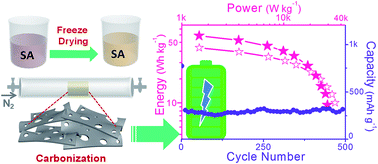Nitrogen-doped porous carbons derived from a natural polysaccharide for multiple energy storage devices†
Abstract
Designing advanced carbon electrodes is considered as one of the most promising directions for energy storage. Herein, we report a facile approach to produce porous carbon nanomaterials. The carbon nanomaterials were prepared via KOH activation using natural polysaccharide-sodium alginate as the precursor with the subsequent introduction of additional nitrogen heteroatoms achieved by further reaction with urea. The optimal electrodes with a high specific surface area (up to 3313 m2 g−1), interconnected porosity, and rich nitrogen (∼7.2 wt%) and oxygen (∼7.4 wt%) doping can achieve an excellent electrochemical performance in supercapacitors and lithium ion batteries. When these materials are employed as supercapacitor electrodes, they achieved an outstanding specific capacitance of 267 F g−1 at 1 A g−1 and an extremely high rate performance with 76.8% capacitance retention ratio in an alkaline electrolyte. In addition, a high capacitance of 197 F g−1 at 0.5 A g−1 with a high capacitance retention ratio of 52.9% at 100 A g−1 can be achieved in an ionic liquid electrolyte. When tested as lithium ion battery anodes, an extraordinarily high specific capacity of 1455 mA h g−1 and a stable energy storage performance up to 500 cycles were observed. The present study highlights that high-performance carbon electrodes can be produced by using sustainable precursor and can be used in multiple energy storage systems.



 Please wait while we load your content...
Please wait while we load your content...